

For my second day in New Mexico, I was travelling to Albuquerque and then heading on to explore some of the surrounding attractions up near Los Alamos. Albuquerque is the largest city in New Mexico by a wide margin, almost ten times the size of Santa Fe with roughly 550,000 inhabitants. While generally less famous than the state capital in Santa Fe, Albuquerque is the economic hub for New Mexico and has been rapidly growing over the last few decades. It's a unique city in many ways, between its high elevation (like Denver about 5000 feet above sea level) to the presence of the Sandia Mountains immediately east of the city to the major swings in temperature throughout the year. Albuquerque has a semi-arid climate where temperatures commonly rise above 100 degrees Fahrenheit / 36 Celsius in the summer, but also gets cold enough to see regular snowball in the winter months. The local environment turns out to be perfect for hot air ballooning, and Albuquerque is famous for the balloon festivals that take place each year. That was my first immediate attraction for the day, as I had booked a sunrise hot air balloon flight and I was excited to see what that would be like.
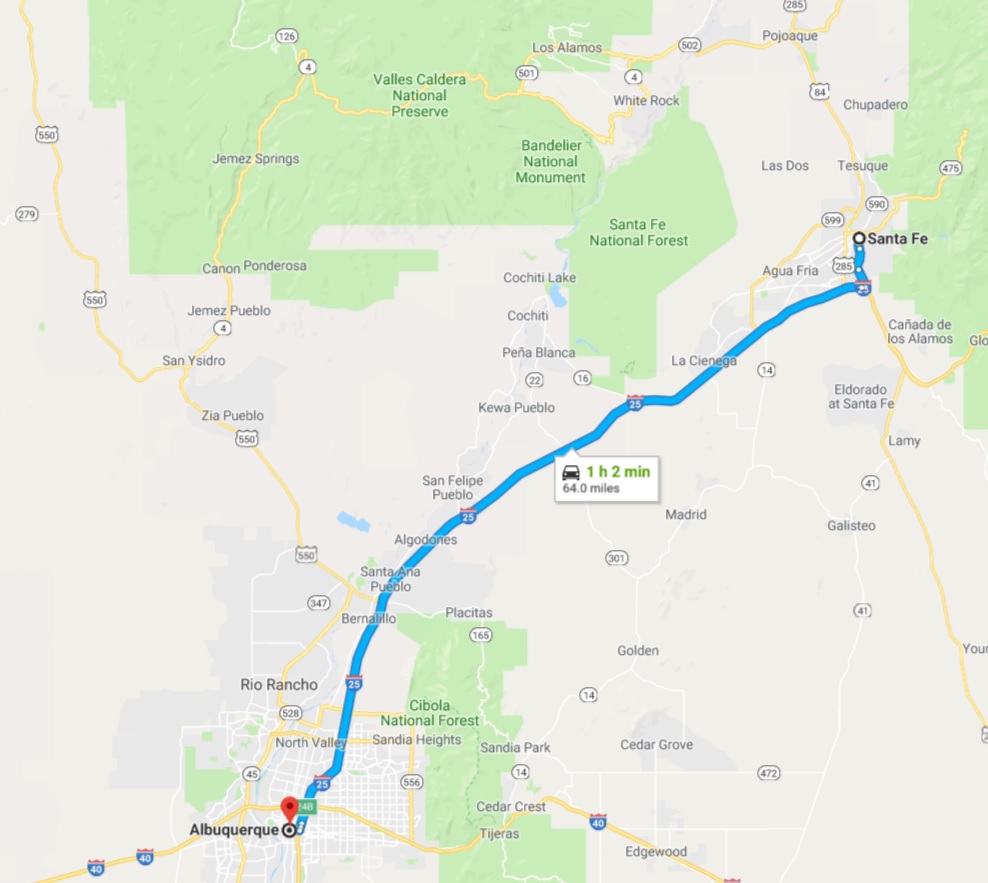
There was one small problem about that whole plan, however. I had booked my hotels before figured out what attractions I'd be seeing in each city, and as a result I had stayed the previous night back in Santa Fe. I needed to arrive at the balloon site very early in the morning, by 5:30 AM, and that mean getting up even earlier to account for the travel time needed. (I would have been better off simply reserving two nights in Albuquerque if I'd known this ahead of time.) Fortunately Santa Fe and Albuquerque are located reasonably close together, at a distance of only 65 miles / 105 kilometers that I could cover in about an hour of driving time. There certainly weren't a lot of other cars on the road at that time to worry about. So I woke up at 4:30 AM back in Santa Fe, hopped into my car and covered the intervening distance at 75 miles/hour, and made it to the balloon site on schedule by 5:30 AM. Even for my travel schedule this was a very early start to the day.

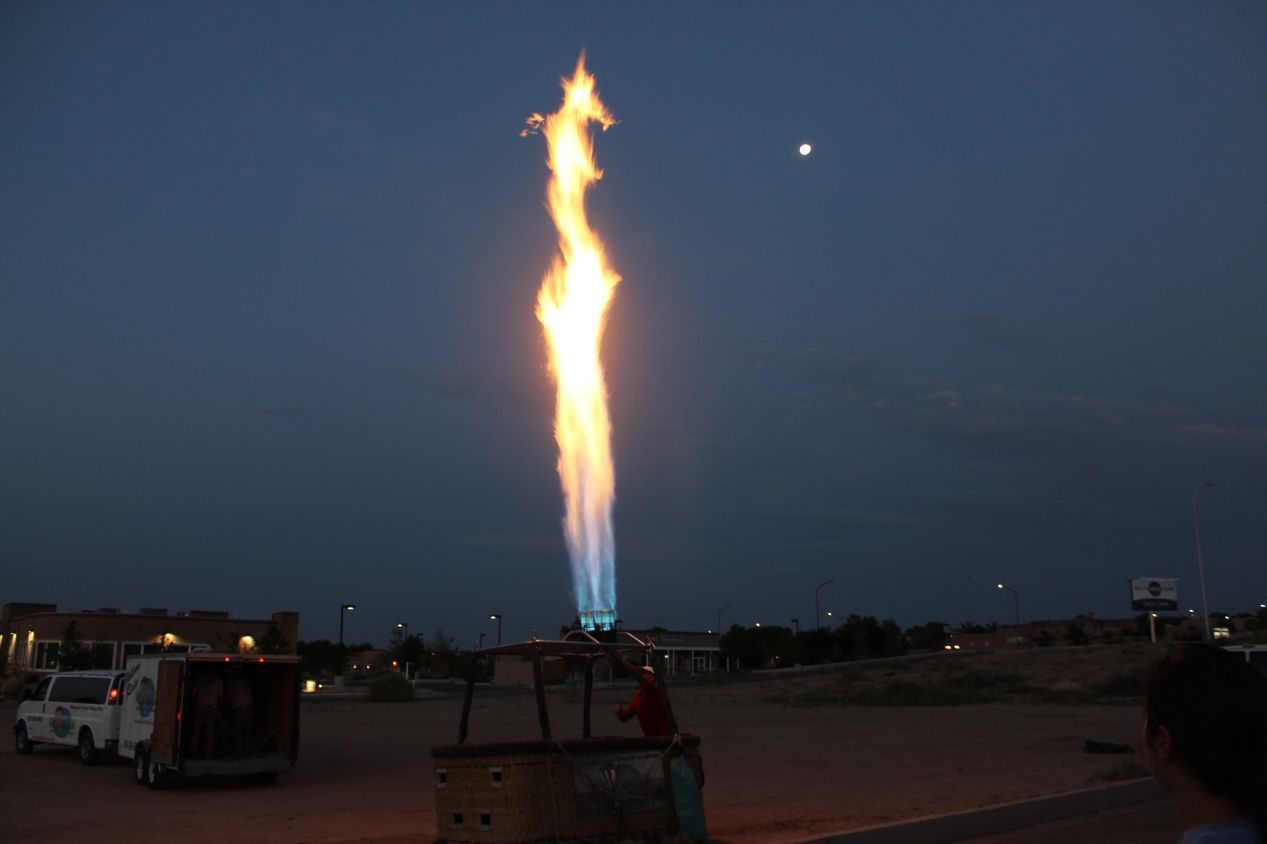


The meeting spot for the balloon launch turned out to be an empty dirt field next to the parking lot of a Panda Express. The main reason for arriving so early was to make sure that no one was missing from the balloon tour group, and to ensure that everyone had time to go over the consent and waiver forms. Hot air balloons are very safe but there's always a little danger in going several thousand feet up into the sky. The staff used this time to start setting up the balloons, which proved to be a fascinating process to watch. First they took out the baskets and set them upright, which required some help from the tourists due to how heavy they are. I love the pictures of the flame device being tested in action; it was still fully dark at this point in time and the camera accurately captured how bright the fire was against the night sky. (The other pictures make it look brighter than it actually was to help capture more details.) Then it was time to get out the balloons themselves and begin the slow process of filling them with hot air. The staff used huge industrial fans to inflate the balloons with hot air, occasionally sending jets of flame into them to keep the temperature hot. It helped make for some great images.

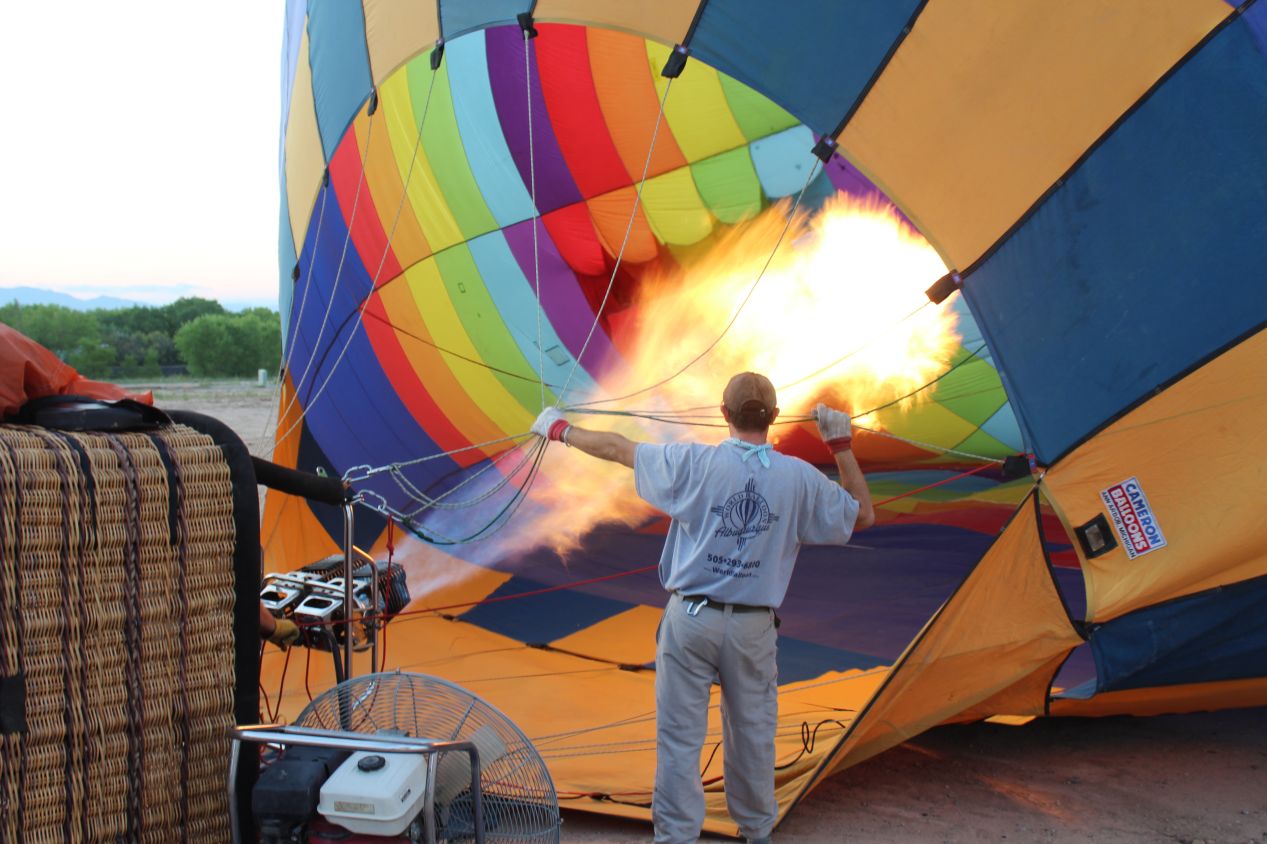


There were three balloons in total launching this morning, and I ended up in the group on the last balloon to depart. That wasn't such a bad thing though, as I was able to watch the previous two balloons take off and photograph them as they launched into the air. I suppose the ideal spot would have been the middle of the three, watching one balloon ahead in the process and one balloon behind still on the ground. Anyway, we had the rainbow colored balloon and watched the same process play out as it slowly inflated over the course of roughly 20-30 minutes. Meanwhile the other balloons were already gathering everyone into their baskets and then lifting off into the sky. It was a little bit surreal to watch these big contraptions just... drift off into the air, especially with no sound at all other than occasional jets of flame. Soon enough my group was also ushered into our own basket, and our mustachioed pilot was preparing to lift us off.

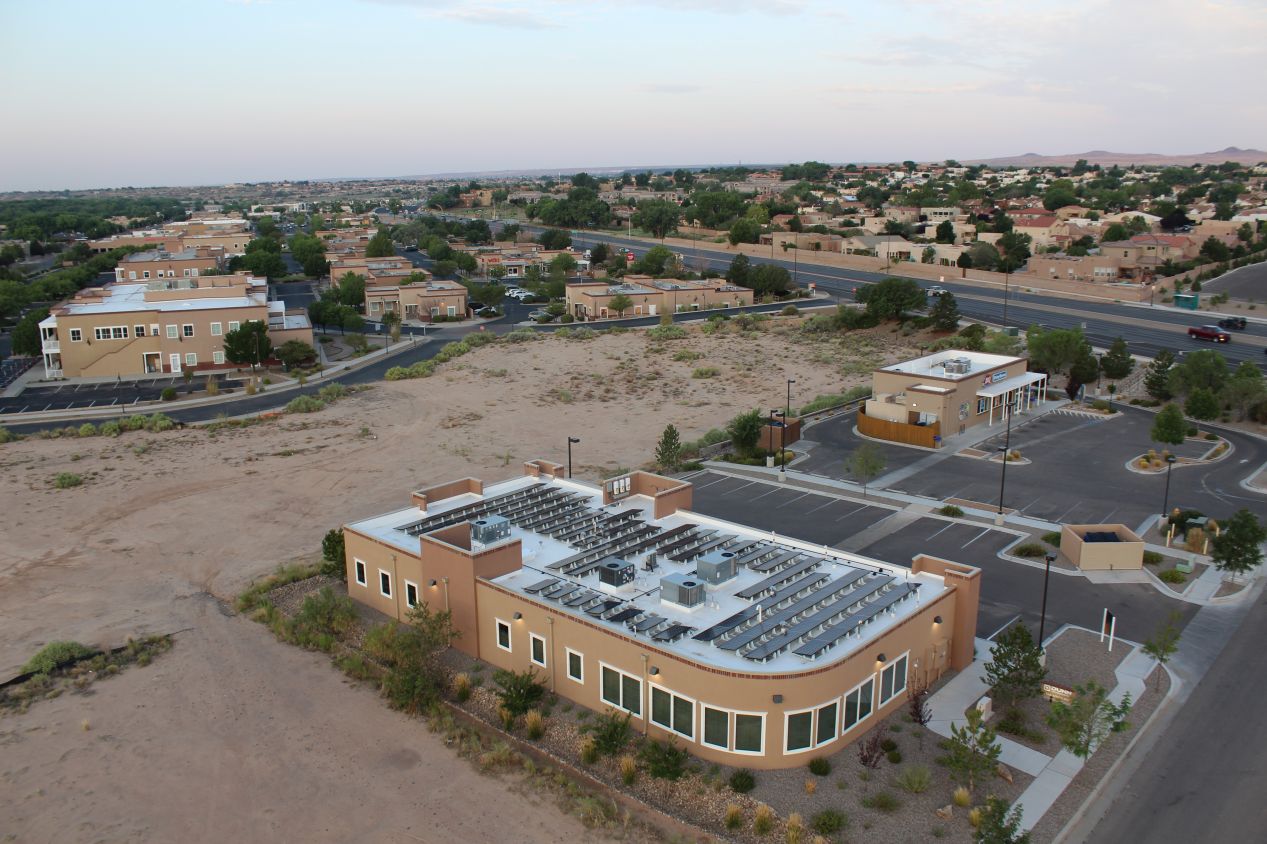


And then the hot air balloon was up in the air and we were flying!  With the other two balloons marking the path ahead, we slowly rose up into the sky and began drifting to the east. The sun was just beginning to crest over the mountains and we had a perfect morning for flying. Riding in a hot air balloon turned out to be nothing like flight in an airplane or a helicopter. The biggest difference was the noise: it was completely silent aside from when our pilot turned on the flames to adjust our altitude. There were no wings or propellers here to dispel the calm of an early morning as seen from several hundred feet up in the air. Of course, there's a rather huge downside to the flight of a hot air balloon: there's no way to control the direction of the flight. The pilot can adjust vertical height up or down by controlling the fire, but the actual direction traveled by the hot air balloon is determined by the wind. This is the main reason why balloons never became a practical mode of transportation. Hot air balloons have been around since the late 18th century without ever developing into more than a curiosity.
With the other two balloons marking the path ahead, we slowly rose up into the sky and began drifting to the east. The sun was just beginning to crest over the mountains and we had a perfect morning for flying. Riding in a hot air balloon turned out to be nothing like flight in an airplane or a helicopter. The biggest difference was the noise: it was completely silent aside from when our pilot turned on the flames to adjust our altitude. There were no wings or propellers here to dispel the calm of an early morning as seen from several hundred feet up in the air. Of course, there's a rather huge downside to the flight of a hot air balloon: there's no way to control the direction of the flight. The pilot can adjust vertical height up or down by controlling the fire, but the actual direction traveled by the hot air balloon is determined by the wind. This is the main reason why balloons never became a practical mode of transportation. Hot air balloons have been around since the late 18th century without ever developing into more than a curiosity.




Fortunately, Albuquerque turns out to be one of the best places in the world for launching hot air balloons due to the predictability of the air currents. At lower altitudes, the winds blow to the east, and then at higher altitudes, they blow in the opposite direction out to the west. This is due to the nearby presence of the Sandia Mountains, and it ensures that the balloons can be launched with a good chance of returning back to where they started as opposed to heading off somewhere random. As we crossed over the river, the balloon pilots sent each one down to ground level, splashing into the waters of the river. I had to snatch up my camera bag from the basket's floor as some water came in through the non-sealed bottom. This is apparently one of the little things that they like to do for fun on each trip, and so I can say as a result that I've been on a hot air balloon ride that splashed down in the waters of the Rio Grande. Higher up, the sun was continuing to rise and provide dazzling early morning views looking out over the city.

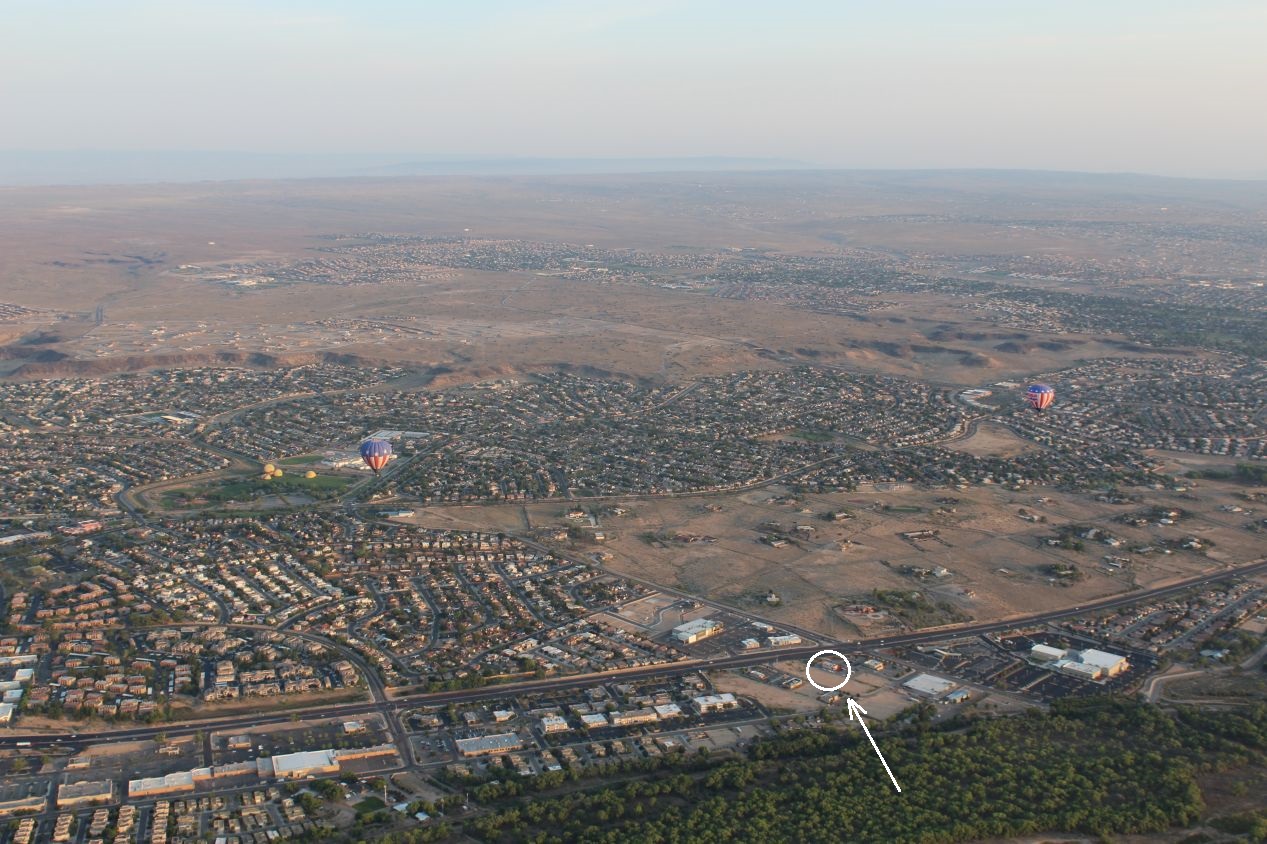


One of the questions that I was curious to ask our pilot was how high the balloons travel in terms of altitude. He answered that we were about 2000 feet / 600 meters above the ground at our highest point on this flight, and that they don't like to go too much higher than that for safety reasons. We could see a long way at this point, even with a slight haze in the air fuzzing things a bit in the distance. Off to the south, we could see the downtown area of Albuquerque where the tallest buildings were clustered in the business district. More immediately below, the running line of greenery that followed the Rio Grande was a stark contrast to the desert flats that ran off to the west. The Albuquerque suburbs came to a sudden end off in that direction and the landscape beyond the houses looked bleak. We could also see the Panda Express parking lot where we had departed (which I've circled above), and several other places where hot air balloons were preparing to launch. There were two places where other ballooning companies were preparing to send up their own vessels; as far as I could tell, my group had been the first one in the air.




After about 90 minutes of flight, we began to descend back towards the ground again. It had been surprisingly warm up in the basket; all of the information that the ballooning company provided had told tourists to dress warmly, but the frequent use of the torch to keep our balloon aloft had made it quite toasty. I was looking forward to having an opportunity to take off my jacket. As we continued descending, it became clear that we were heading into a suburban neighborhood. I could see individual dogs in the fenced yards below, several of them barking up at our balloon as it crossed by low overhead. Our pilot was trying to head towards a parking lot but didn't end up making it. We would be touching down in the middle of the street in a random neighborhood instead. The landing is the trickiest part of the whole flight, and we were given repeated warnings about how to lean sideways in the basket and take the pressure off of our feet to ensure that no one was hurt. I understand that there's a similar concern when skydiving: land directly on your feet and it's easy to break your legs. Fortunately everything went off without a hitch and we were down on the ground once more.

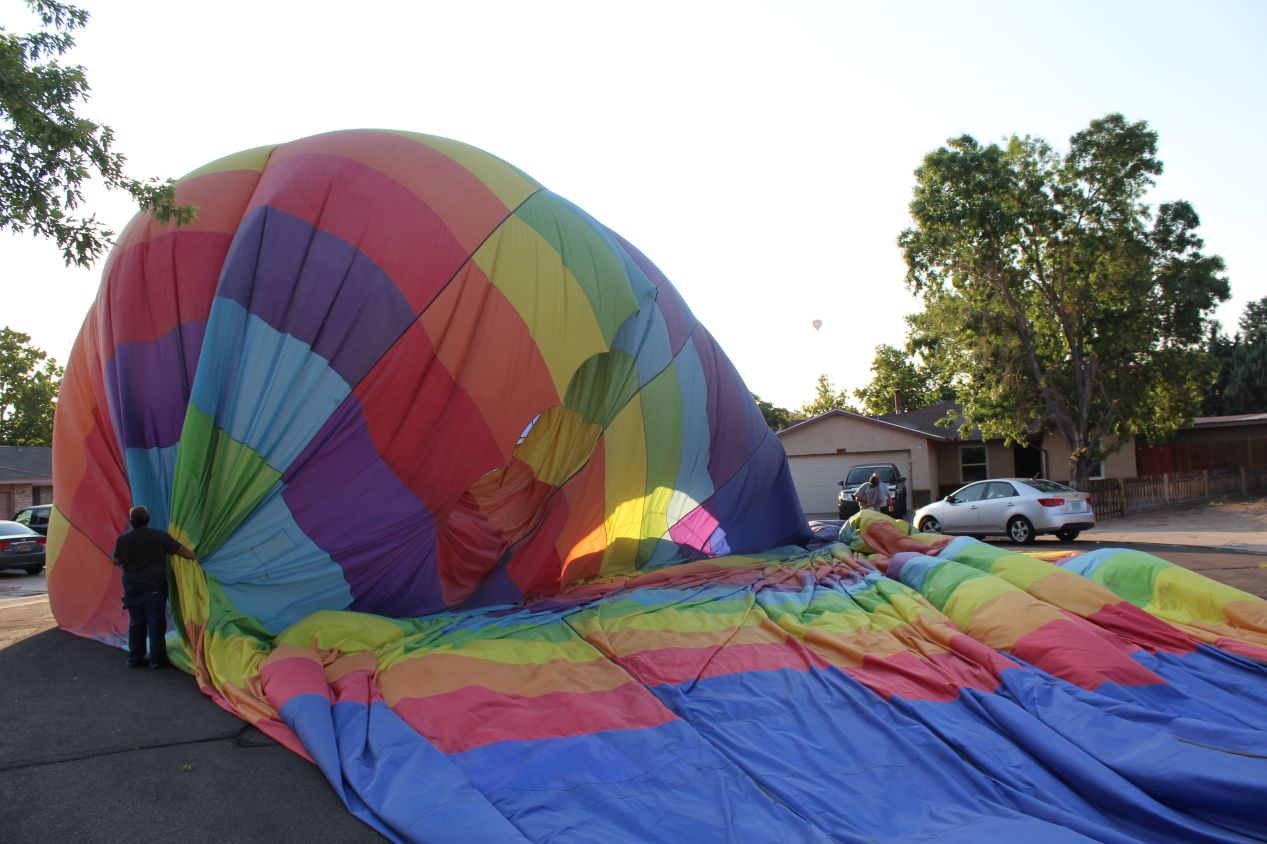


As I mentioned, we ended up on a random street in the middle of a bunch of residential houses. A man ran out of his house and helped stabilize the balloon after we touched down; he had no connection to the ballooning company and simply wanted to help out - what a nice guy. He also said that he was worried we were going to hit his house, which our balloon cleared by all of five feet before landing. Anyway, at this point we helped the pilot and the ballooning staff (once they arrived with their truck) to fold up and then pack the balloon. The whole thing was able to fit into a sack carryable by a single person, kind of like those camping tents that somehow fold up into a little travel bag. I'll also mention that the balloon itself was surprisingly dirty, and my hands were covered in dust by the time that I was finished folding it up. Those things look graceful and clean in the air, but yeah, not so much in reality up close. Then it was back to the Panda Express parking lot again for a morning celebratory champagne drink, which I probably shouldn't have had given that I was immediately about to drive again. There was even a cute dog there that I had the chance to pet. Overall, what an experience this was. While it was pricey at about $150 for the balloon flight, it was so very much worth it. Hot air ballooning is one of those rare things that's worth doing just for the stories that you can tell aferwards. (Also: taking selfies in the balloon was a nerve-wracking affair. I was very worried that I would drop my phone and that would surely be the last I'd ever see it.)

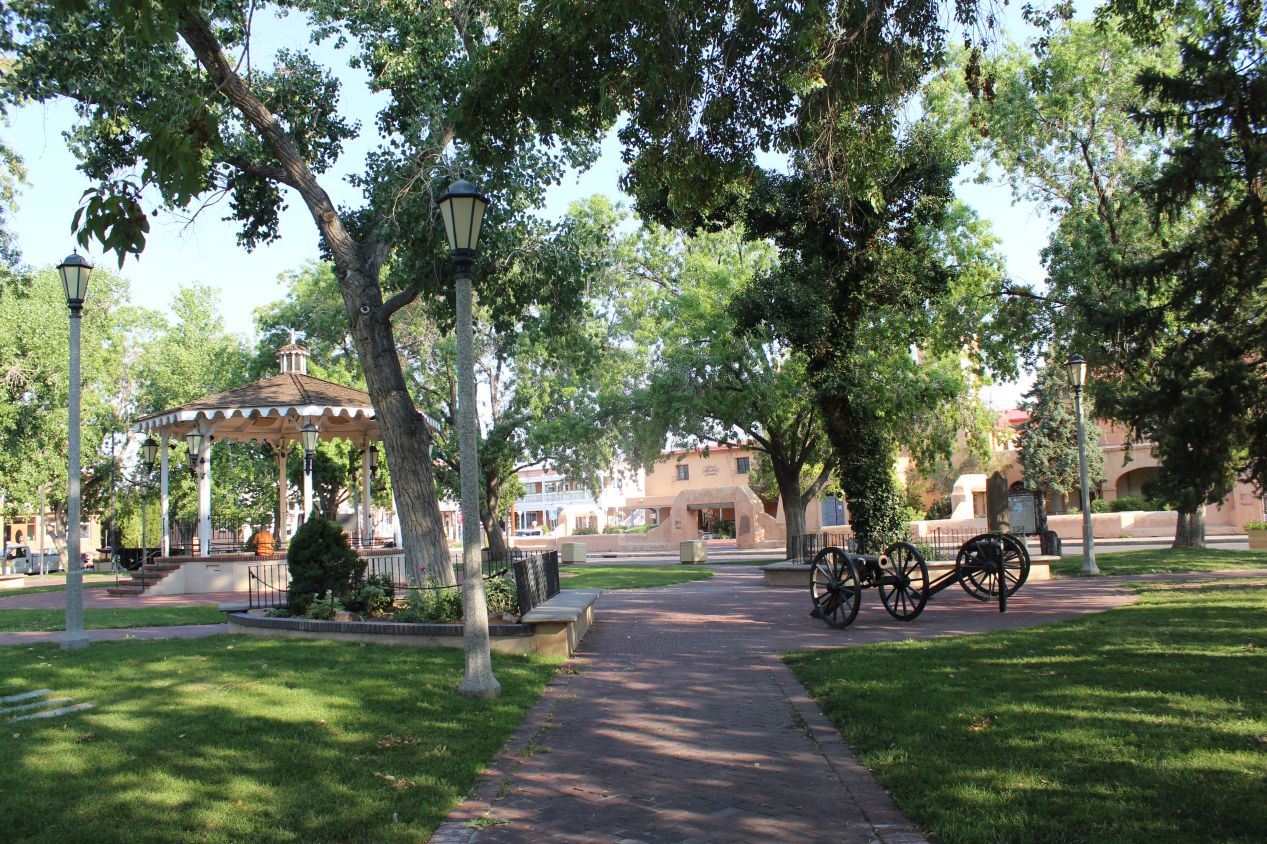


Oh, and it was all of about 9:00 AM at this point in time. I still had the entire day ahead of me for sightseeing, as long as I could avoid dropping from exhaustion at least. I started out by making the short drive to Old Town Albuquerque, the central plaza of the original Spanish colonial town founded back in 1706. Like the other cities that I'd been seeing in New Mexico, Old Town Albuquerque consisted of a central plaza originally surrounded by government buildings, homes, and a church. The church still remained today but everything else had been converted into small stores and restaurants designed to cater to tourists like me. This particular house of worship was named San Felipe de Neri Church, built in 1793 and one of the oldest remaining buildings in the city. It looked similar to many of the churches that I had seen the previous day in Santa Fe, with traditional adobe construction for the walls that was later embellished with Gothic-style bell towers during the Victorian period. San Felipe de Neri was closed when I arrived on this early Monday morning, and pretty much everything else in Old Town Albuquerque was closed as well. It was very quiet and practically deserted, a stark contrast to the huge crowds in Santa Fe Plaza the day before. I decided to walk around a bit more and see if anything opened up as the morning progressed.

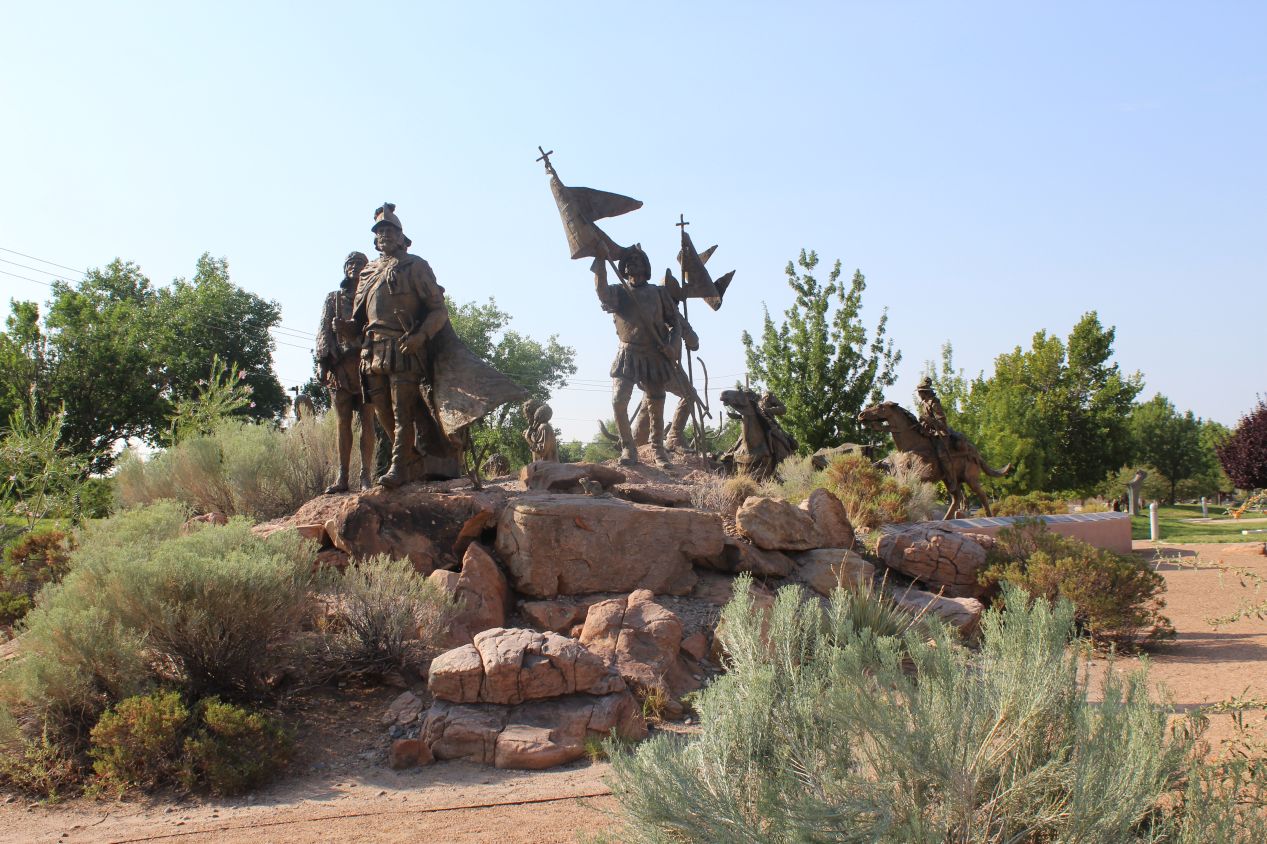


The museum district was located within walking distance of the Old Town plaza, and that was where I headed next. There were several museums to be found here, with the first once pictured above known as the Albuquerque Museum of Art and History. This is the kind of place that I normally would have stopped to see, except that I had just explored a similar museum the previous day at Santa Fe's Palace of the Governors. I didn't need to visit a second museum about local New Mexico history which would likely cover much of the same ground. Instead, I continued down the same road and found my way to the New Mexico Museum of Natural History and Science, the place with dinosaurs prominently displayed outside. I remembered visiting the museum in Illinois where they had regretfully explained that there weren't many fossils from the Mesozoic period to be found in Illinois; that was emphatically not the case with New Mexico, where the dry climate has done a fantastic job of preserving dinosaur remains. I decided that it would be fun to explore this museum and bring out the eight year old version of myself once again.

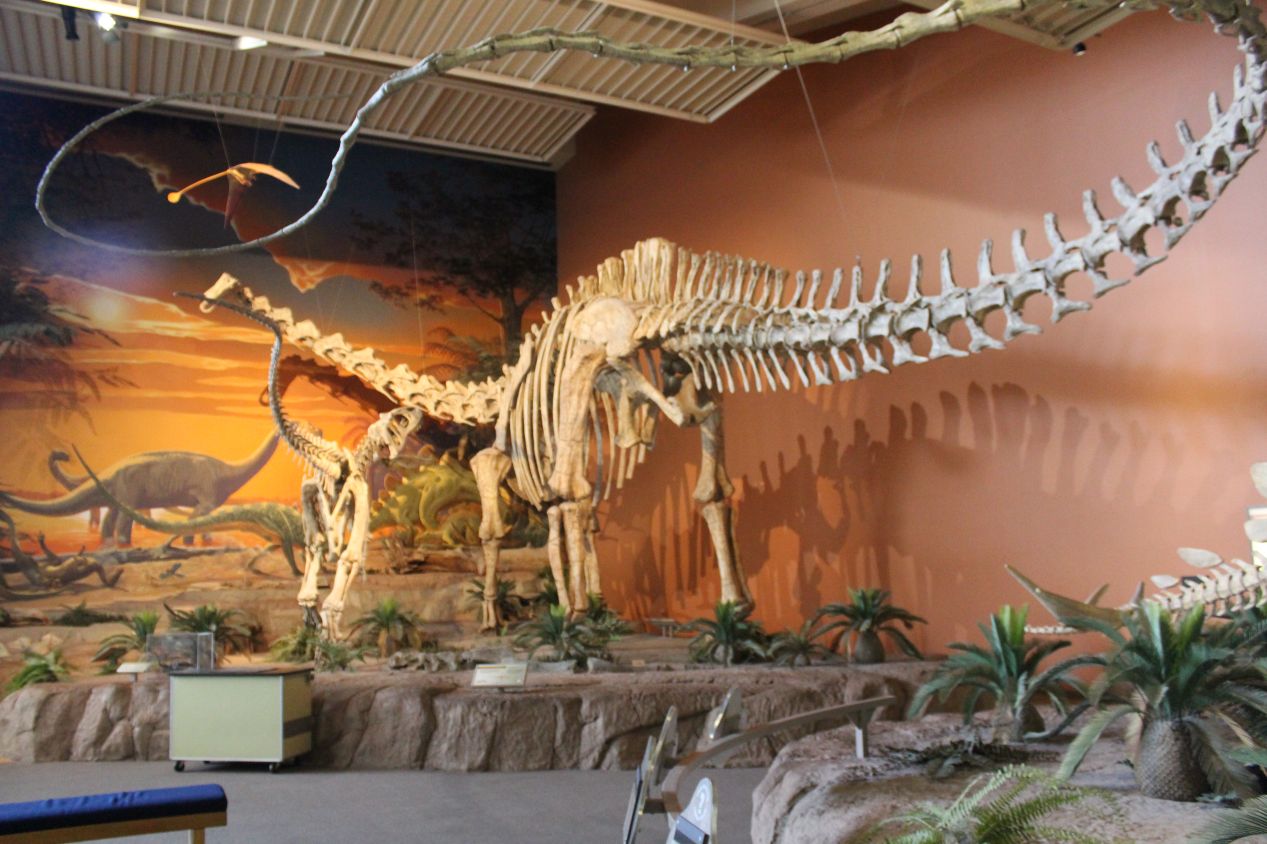


This was a museum of natural history, and the main exhibit walked visitors through the many different life forms that have lived in what is now New Mexico over the last several hundred million years. The dinosaur collections here were excellent for a museum of this size, with a full-sized replica of a giant sauropod dinosaur (I don't remember the exact species) that left me in awe of their incredible length. It's hard to imagine creatures that big walking around on land, although I guess it's fair to point out that blue whales still exist today and are even larger. The museum did a nice job of discussing how the climate of New Mexico had changed over time, with daily "weather reports" from different periods in the past explaining how the state once had a tropical, wet climate nothing like its current state. The main exhibit ended with a section on the most recent Ice Age and the dangers of the current rapidly heating global climate. There was also a separate area about space exploration, which wasn't as comprehensive but still had useful informational displays. This would be a great place to bring young kids and let them spend a few hours poking around at the dinosaurs on display.




After finishing up at the museum, I walked back to Old Town Albuquerque via a slightly different path through Tiguex Park. The area had become livelier since my first arrival, with many of the small boutique stores now open for business and a scattering of other tourists walking about. I enjoyed seeing how this area used cactuses as decorative elements, like a distinctly Southwestern version of a flower bed. There was one other attraction that I decided to stop and see while I was passing through this area:

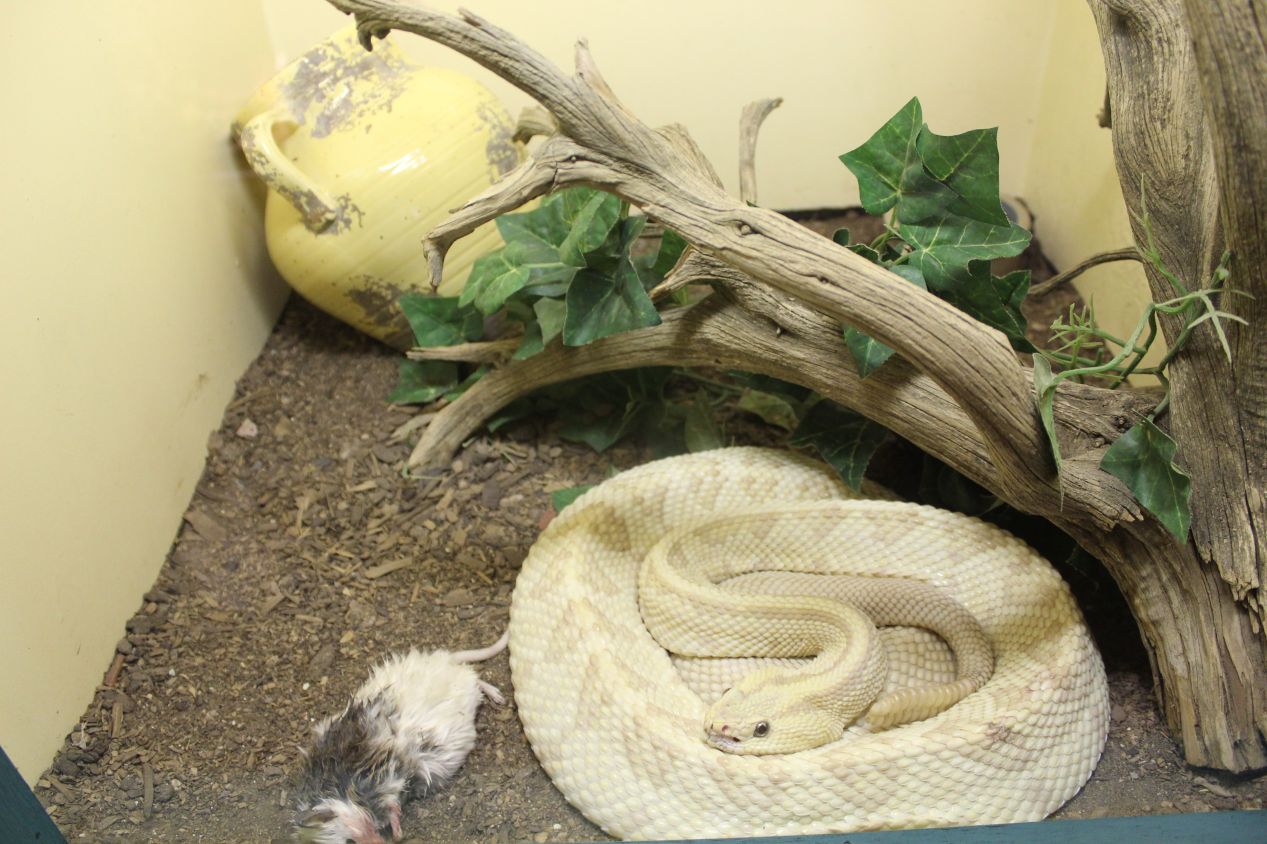


That was the Rattlesnake Museum, a place unique to Albuquerque which showcased rattlesnakes of all different types. The small museum didn't charge much in the way of an entrance fee, and I found that it was pretty much exactly what the name suggested, a building with several dozen snakes on display. The informational content on display here was pretty simple, mostly consisting of basic facts for each animal about their size and habitat out in the wild. There was also some information about the appearance of snakes in popular culture, although that clearly wasn't the focus of the museum. This place felt like something put together by amateur enthusiasts rather than professionals, and the quality was definitely lower than most of the other museums that I'd been visiting. Still, the Rattlesnake Museum was doing the best that they could with a limited budget even if a lot of the information felt a bit outdated. And let's face it, when you go to a place called the Rattlesnake Museum, you pretty much know that you're going to see a bunch of snakes. This is probably skippable for most visitors.
It still wasn't even noon yet and there wasn't too much more for me to see in Albuquerque. While I could have spent more time in the downtown area or visited additional museums, I had decided that I would use the rest of this day to explore some attractions in the Los Alamos area instead. Unfortunately Los Alamos was a pretty good distance away, about 100 miles / 160 kilometers off to the north. It was actually fastest to drive back to Santa Fe again and then head west from the New Mexico state capital. Therefore I made the drive from Santa Fe to Albuquerque very early in the morning, then drove back again in that direction en route to Los Alamos a few hours later, and then repeated the original drive yet again in the evening. As a result, this ended up turning into a fairly lengthy driving day as well since I kept driving in circles.




The main attraction that I wanted to see in Los Alamos was Bandelier National Monument. Located a short distance outside of the town itself, this is a park area that preserves the cliff dwelling homes of the ancestral Pueblo peoples from the Precolumbian period. Visitors can't travel directly to Bandelier National Monument, and instead must park in Los Alamos at a visitor center and then take a shuttle bus that runs every half hour to the park area itself. I managed to time this perfectly and hop on the 2:00 PM bus by arriving about two minutes before it left, therefore avoiding the need to wait for the next one. The visitor center within the monument itself was a small affair, with some basic information about the Pueblos people who had lived here and their amazing living spaces built into the natural environment. The terrain itself in Bandelier National Monument was highly unusual, a series of canyons cut by flowing water through high cliffs. I included a picture of the topographic map to provide an example of what this looks like from above. The main walking trail ran through one of the largest of these canyons and I would have the chance to see some of the ancient dwellings for myself.

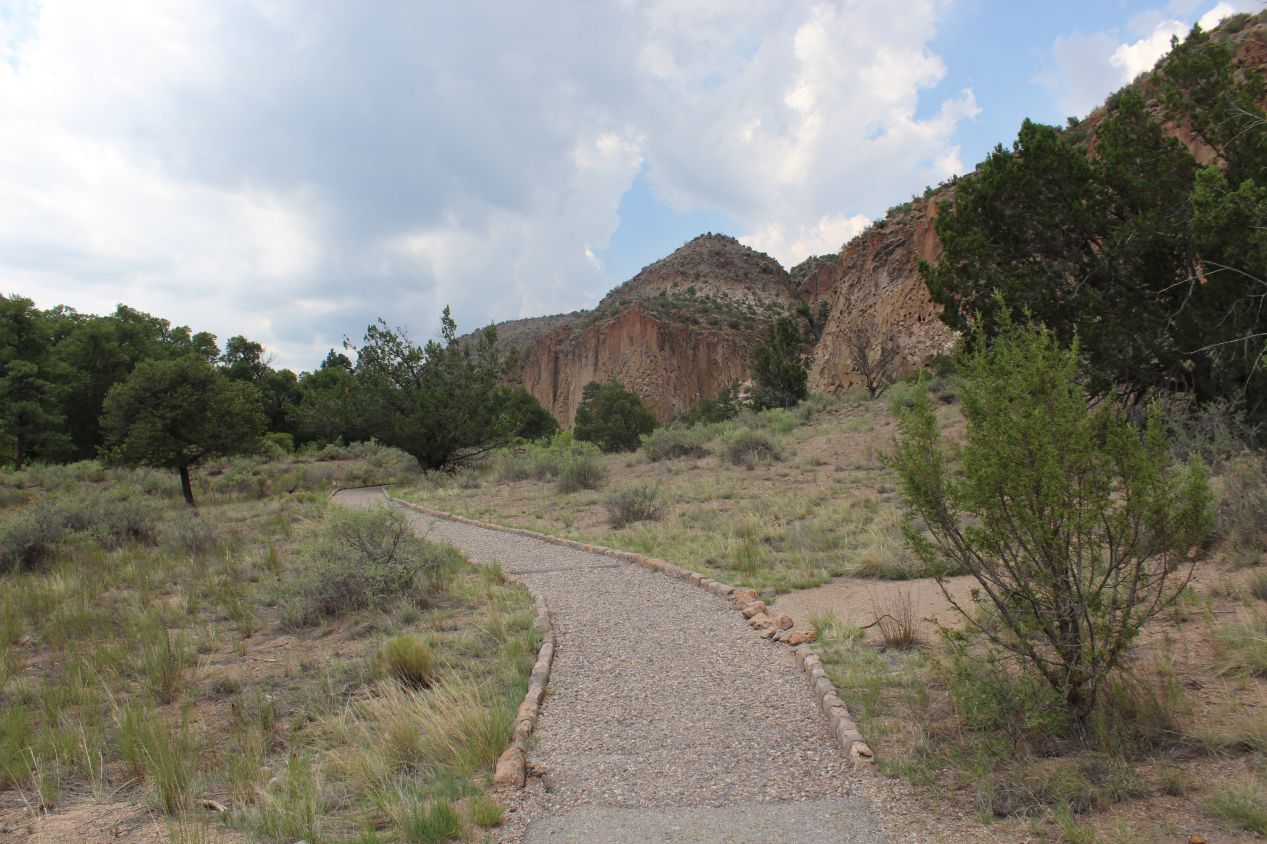


I didn't have too much time to spend at Bandelier National Monument before the last shuttle bus of the day would leave in a few hours, and as a result I followed the unoriginally named Main Loop Road trail to the most famous attractions in the park. The path winded its way through a forest in Frijoles Canyon, with a small river running off to my left and the tall canyon walls running off to my right. I could see that there were openings in the canyon wall in the distance, some of which the Pueblo had used as sheltering places for protection. There were also the stone foundations of more traditional houses down in the canyon itself. Those were more vulnerable to flooding from the river, however, which is still a danger today. One of the guides on the shuttle bus mentioned that a hiking trail that ran along the river was completely destroyed within the last five years when heavy rain flooded that part of the canyon.

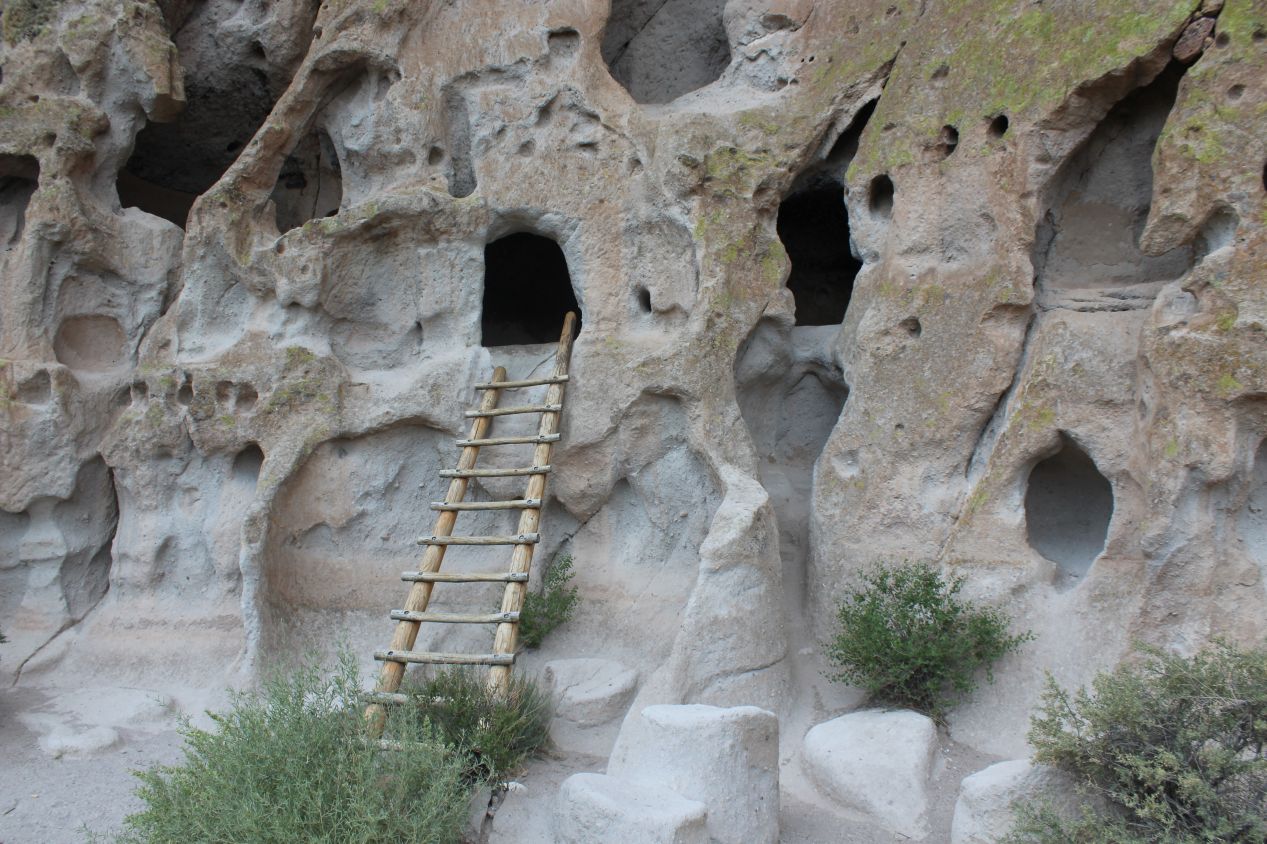


After about half a mile of walking, I reached the area with the greatest evidence of human habitation. The remnants of a small village were visible here, staked out in a circle surrounding a central open area. Several hundred people had lived here at one time, and archaeologists have dated the structures at Bandelier National Monument to somewhere between 1200 and 1500. This was an era when the local climate was undergoing changes, and the Pueblos migrated to the region from an area further north that was becoming too dry. The path then winded up to the cliffs above the village, where natural openings in the rocks known formally as cavates had also been used by the Pueblo. These naturally-forming spaces were created by voids in the volcanic tuff of the canyon wall and then carved out further by humans. The park service has constructed a series of steps and ladders to help make these areas more accessible, which would have been easily defensible when they were first created. The views from along the cliffs were excellent, providing a high vantage point looking down at the rest of the canyon.

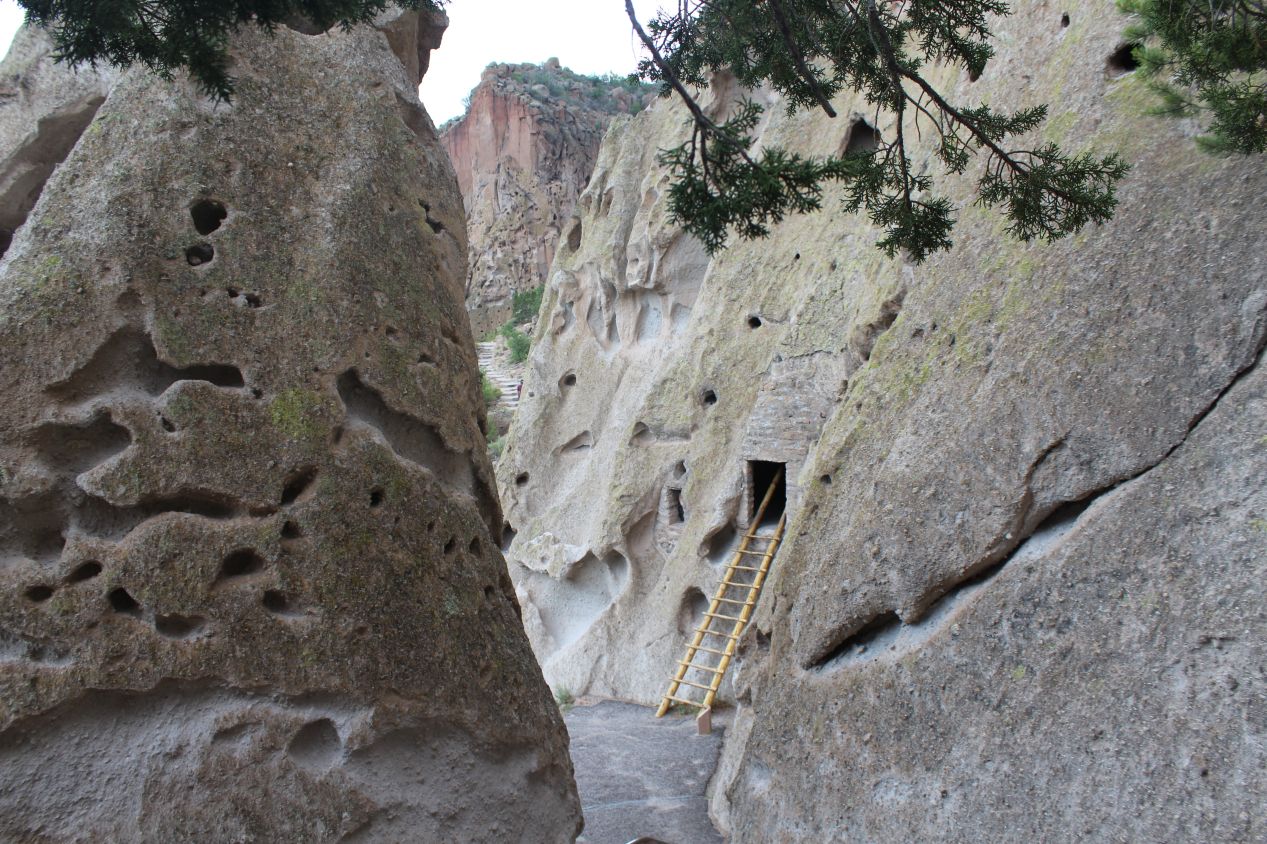


This was the best view that I was able to get of the unnamed village down below. The trail ran alongside the cliffs for some time here, with many of the openings accessible from the walking path. I even thought about using one of them for shelter, as the skies decided to start raining again for about ten minutes while I was exploring the area. That was annoying since I'd left my jacket back with my car outside of the national monument. Fortunately the rain stopped after a short time, although it did leave the rocks along the cliffs somewhat on the slippery side.

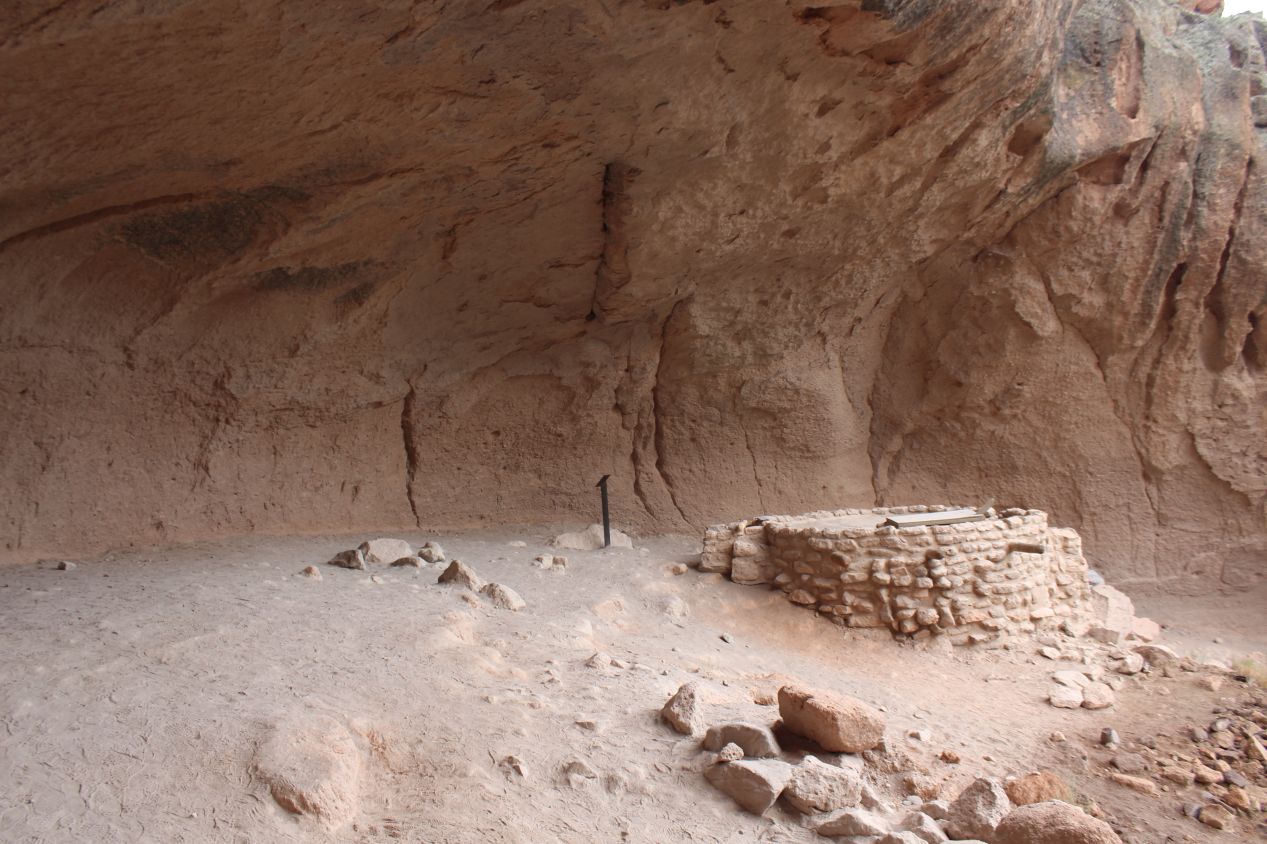


When I reached the back end of the Main Loop Road trail and it started to turn back towards the visitor center, I saw a sign mentioning that there was an additional half mile walk to something known as the Alcove House. This seemed like a short enough distance to travel, and I took the extra time to continue further down the path. I was glad that I did, as the Alcove House proved to be the most interesting part of Bandelier National Monument. This was the largest of the cliff openings, where visitors were able to ascend 150 feet / 45 meters up a series of ladders to an open space with great views of the canyon floor. It was fortunate that there were only a couple of other people here since the going was single file with only one person at a time. I was reminded of a similar setup at Mesa Verde in Colorado, where a different group of Native Americans had also constructed buildings on the side of a cliff. This was an amazing place to see and definitely worth the extra walking time needed to reach the Alcove House. I ran most of the way back so that I would be able to catch the 4:00 PM return shuttle bus and made it with about five minutes to spare.


These two pictures were taken at a scenic overlook after I returned to my car in the area near Los Alamos. This was a beautiful stretch of scenery in northern New Mexico, with a series of rock formations dotting the landscape and green bushes covering the slopes of the hills. The environment looks nothing at all like this in my home state of Maryland, and this was an iconic little snapshot of the terrain in the American Southwest.

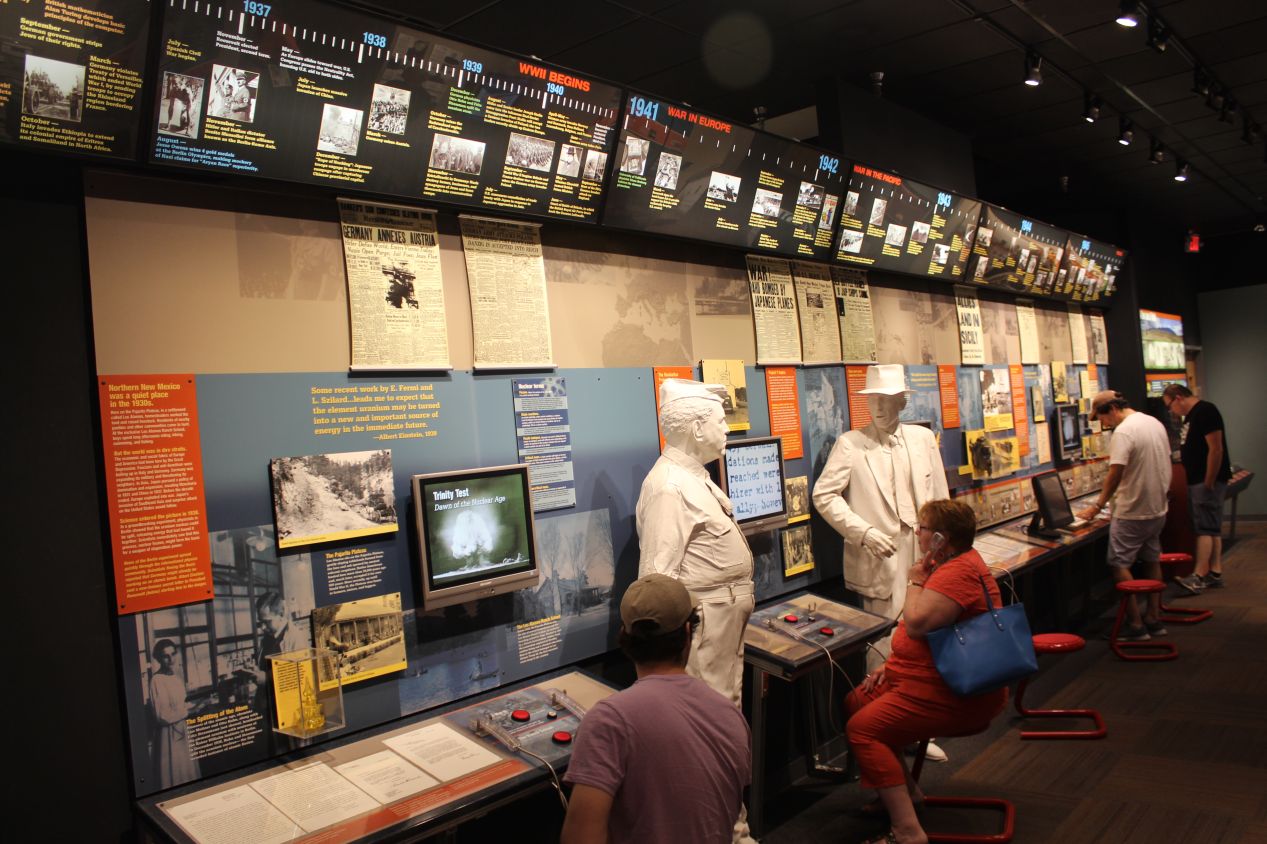


Los Alamos, New Mexico is best known for hosting the Manhattan Project effort that developed the atomic bomb during World War II. The US government picked Los Alamos due to its remote location in the middle of nowhere, which helped maintain the secrecy surrounding this new superweapon. I was hoping to visit some of the places in Los Alamos associated with the Manhattan Project, but I found that access to Los Alamos National Laboratory remains strictly classified and the public can't really go there to get a tour of a place that remains secret. Instead, the main local museum in Los Alamos was the place pictured above, the Bradbury Science Museum, which was focused on national defense and atomic weaponry. This was the place to go to learn more about the Manhattan Project, including full scale replicas of the two bombs dropped on Japan. There were many more displays discussing the various national security issues surrounding nuclear proliferation and the defense projects that the Los Alamos lab has worked on in the decades since World War II. While this was all fascinating stuff, I was slightly disappointed at the inability to tour the actual locations where work had been carried out on the Manhattan Project. The Bradbury Science Museum is still worth seeing, but it's not a top tier destination for this very reason.

I also need to mention that I had my best dinner of the whole trip in Los Alamos this evening. There was a local restaurant across the street named China Moon which had an all-you-can-eat buffet at a very inexpensive rate, something like $12 per person. I was able to get as much as I wanted of all different types of Chinese servings, with about two dozen different types of entrees available. I was one of the first ones in the restaurant when they opened for dinner, and everything came out of the kitchen fresh and hot and delicious. I ate two full plates full of food and could have had several more. Given the inexpensive cost of this place, China Moon was even better than the fancy steak dinner that I'd eaten back in Lincoln, Nebraska. This restaurant was nothing less than fantastic.

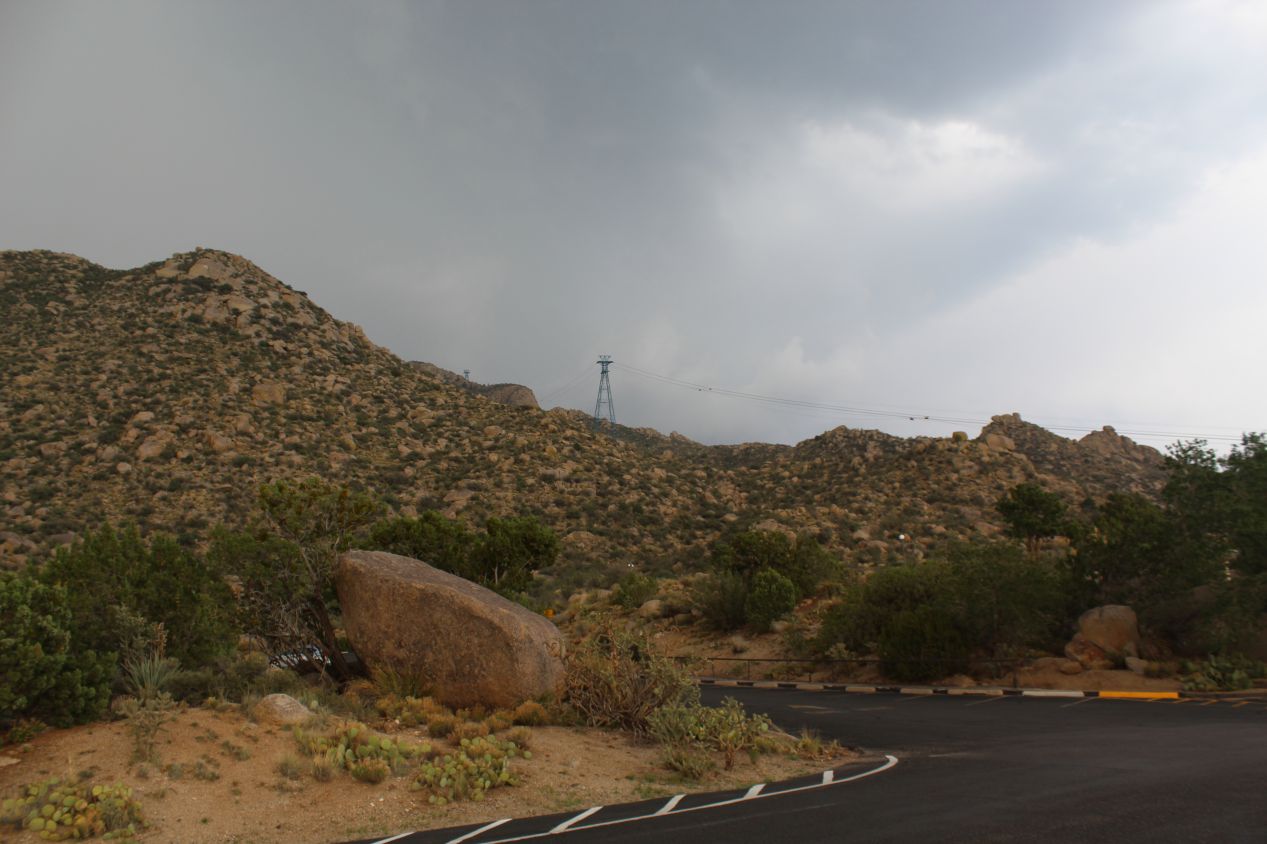


I had planned one more event for the day, an evening ride on the Sandia Peak Tramway up to the top of the mountains overlooking Albuquerque. This was an attraction that stayed open until after darkness fell, and I had been planning to visit the tramway last for that very reason. A trip up to the top of the mountains would give me some more outstanding views looking down into the valley at the city below. However, nature decided to take a hand and interfere with those plans. While I was driving from Los Alamos back to Albuquerque, I noticed a wall of dark clouds building off to the west. There was a very intense storm heading my way, and it was about to arrive even as I pulled my car up to the tramway entrance. The staff told me that they had shut down the operation due to concerns about the storm, and with a visible stormwall heading towards us, that made a great deal of sense. I thought that maybe I could at least explore the tramway station at the bottom, but that was when the storm finally arrived and drove all other thoughts out of my head.


A torrential downpour opened up, and for the third time on this vacation I found myself in a situation where it was raining so hard that I could barely see a thing. The rain alone was bad enough, but this storm also brought hail along in its wake. Pea-sized nuggets of hail fell from the skies and left a staccato drum beat on the roof of my car. It was bad enough that I pulled my car underneath the limited protection of a tree because I was worried that the hail was going to start smashing up the windshield. Over on the side of the road, the hail began to pile up and coat the ground in a layer of while, looking like snow in the brief minutes before the heat outside began to melt it. This storm brought high winds as well, and it was legitimately dangerous for anyone to be outside in these conditions. I was baffled by these repeated bouts of violent weather that I kept running into on this trip. Was I just phenomenally unlucky during the course of this week, or are the storms that much worse out here near the Rocky Mountains?
My unsuccessful attempt to ride the Sandia Peak Tramway finally brought this long day to a close some 16 hours after I had first woken up. Weather notwithstanding, it was a wonderful day of sightseeing and I was fortunate indeed that the rains had come at the end of the day instead of at the beginning. I had ridden other tramways before but never a hot air balloon. Together with the trip up to Bandalier National Monument, this was easily one of the best days on my whole trip. Next up would be my last day in New Mexico, as I sought out the natural beauty at White Sands and Carlsbad Caverns. It was time to swing to the east and begin the long return trip home.



